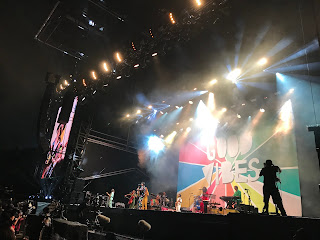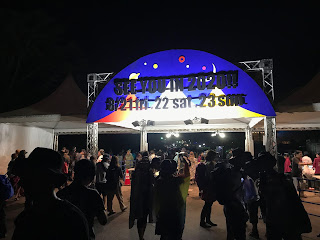Fuji Rock Festival 2019, Day Three
If not entirely, the sun did come out for the last day of this year’s Fuji Rock Festival. Got to the site earlier than usual and skipped the tororo at Oasis because, for the first time, I caught an act at the Pyramid Green stage, not so far from where the buses drop the commuters every morning. I Got to walk around the camp site and was surprised for not seeing any damage from the previous night ravishing storm.
In a very small stage for the festival standards, decorated with chandeliers and drapes, I saw Yakushima Treasure, a project that’s a collaboration between the lead singer of Wednesday Campanella and the lead singer of Asian Kung-Fu Generation. They both released an EP earlier this year that showcases their more experimental side. Maybe that’s why instead of the packed place I was expecting, there were roughly 100 people there, maybe even less than that. A surprising fact considering that I saw Wednesday Campanella at the Red Marquee along with a huge crowd two years ago and that Asian Kung-Fu Generation played the Green Stage on the previous day. Nonetheless they delivered a nice flowing set that went from slow building electronic droning sounds to a more upbeat accessible and dance oriented ones. It made me curious to check their record.
Thirty minutes into their set we left to walk for about three kilometers to reach the Field of Heaven stage at the other end of the site, to try to make it on time for Shibusashirazu Orchestra, a huge collective of musicians and dancers. Having heard a lot about the strength of their live shows, my expectations were high, but I was blown away as soon as they hit those power chords that opened their set. Along with a front line of a ten piece horn section, two drummers, at least three guitar players, percussionists and a conductor, there were four singers and two main dancers pumping the crowd. A woman waving two huge plastic bananas and another in a sheep outfit. In the middle of all there was a skimpy dressed MC who’d interact with the audience from time to time. This explosion of color was contrasted with a couple of Butoh dancers, the type of Japanese modern dance usually performed in white makeup exploring the infinite possibilities of movement and expression. They provided the dark yin to the bright yang in a way that made both intrinsically interconnected. The music was funky with avant-garde flourishes. The perfect combination of Coltrane, Parliament, Sun Ra and Machito, and I haven’t even mentioned the large sized marionette of a saxophone player on the side. Their presentation was a moving reminder of the need for experimenting and the importance of daring to be different. In a society that seems to favor uniformity, Shibusashirazu embraces differences and the harmonious cohabitation of ideas that on paper look like polar opposites. It’s the basis of their unified concept. The longing and constant quest for freedom.
Next in the Field of Heaven another unique band made its debut in Japan. From Thailand The Paradise Bangkok Molam International Band teared it up with its instrumentals. Their music is a fusion of traditional Thai music with dub, blues and even disco elements. According to Wikipedia the molam in their name comes from the traditional music from the Thailand-Laos region in which a khene player accompanies a singer. The khene is a bamboo mouth organ that looks like a cross between a harmonica, a pan flute and a pipe organ. In the band the khene provided the base for the phin player (a type of traditional Thai lute) to rip solos that were the melody on top, while bass and drums lay down the groove. Along with contributions from a percussionist on finger cymbals that shouldn’t be underestimated. With this minimal instrumentation they were able to deliver a hard hitting set that kept the audience cheering in approval whenever the bass dropped after the build ups and crescendo. The crowd cheered for an encore even after they went over the allotted time. It was another captivating set.
I then decided to take a break and looked for some green tea to no avail in the Field of Heaven area. I headed out towards the White Stage and realized that a Cuban band was performing there at that time. The reason why I didn’t circle Interactivo in my schedule was purely political, I got to admit skepticism about any band coming from that country and about the possibility of them being supporters of that regime. But something was said on stage that kept me there and ended up seeing them for about 35 minutes. As most professional Cuban bands they were as tight as it could be. Female and male musicians in equal terms grooving in that clockwork clave beat with added influences from funk, rap and reggaeton, relying purely on musicians. They got the crowd going. It was a nice random coincidence they were playing as I was passing through that area. I was glad I could see them.
I headed back, past the Field of Heaven, and went to a stage resembling a small indoor club, called Cafe de Paris. The legendary trumpet player Toshinori Konda, who was a member of Peter Brotzmann’s Die Like a Dog Quartet was about to take the stage with his own group Ima-21. They have records dating back to 1984 and have that Bill Laswell late eighties-early nineties sound of bands like Material going. Following the tradition of singing trumpet players, Konda will sometimes grab the mic and do a bit of rapping and singing. The jazz rock fusion with some free elements sounded still relevant and it was awe-inspiring.
Taking the type of Afrobeat explored by TP Orchestre Poly-Rythmo de Cotonou in the seventies and adapting it to the 21st century’s sensibilities is what Vaudoou Game is all about. With roots in Togo and based in France, this multicultural band captivated a mid-afternoon crowd at Field of Heaven with their personal take on Afrobeat. Lead vocalist and guitarist Peter Solo engaged in stage banter rebuking misconceptions about Voodoo, the ancient African religion, while pumping the crowd. The man does have lots of charisma. Maybe because of the natural setting, the elements clicked and the performance was memorable in so many levels. There was a cappella singing from the whole band, moments in which they dropped their instruments in favor of agogo double bells, choreography and seventies inspired outfits. But above all there was the music that was both infectious, constantly shifting and never boring.
It was time to head back to the main stage to see if there was a chance to grab a spot by the rail for the headliner. The scheduled artist before the headlining band was Jason Mraz. I was there for the whole show at a decent spot, waiting for the end of it to try to grab that rail. This was the main thing on my mind, honestly I wasn’t paying too much attention to the show. I liked how the band was mostly women and how they interpolated the Jackson 5 I Want You Back and did a couple of choreographed moves based on it. His music is not my cup of tea and I can’t think what the organizers thought he had in common with the headliner, he even joked from stage that his keyboard player was a big fan in a sort of ironic way. It was a good show for that type of music, that’s for sure, but way too happy for its own sake.
Luckily I grabbed the spot and waited for over an hour there to check that one off of my bucket list. In Latin America, where I come from, I’d argue that The Cure are like The Beatles. Over there rock music became more present in the eighties and Robert Smith’s band was the main influence. I remember watching commercials on TV for the Standing on a Beach singles compilation, which I got at the time of its release. Another element that turned them into eighties icons was their videos, most of them directed by Tim Pope. They displayed a vast amount of creativity using props in the most unique ways imaginable and they were completely different from anything else at the time. Having never seen them and being a fan for over thirty years, I was ecstatic when they were announced.
They opened with the first two songs from what it’s regarded as their masterpiece: Disintegration. A bold move due to the slow tempo of each song. Something caught my eye and it was the absence of Simon Gallup on bass. It was later explained that it was his son who replaced him due to a personal emergency. Even though Gallup was missed, his son did an amazing job replicating his sounds and moves. By the time they played High, which it’s in my opinion one of the best love songs ever written, the whole situation was overwhelming in an emotional level. There is something magnetic about them, the quality of the material, the integrity of a sixty years old frontman that embodies the rock and roll lifestyle with a voice as clear and powerful as the records from the seventies, still capable and willing to move from time to time like he did in those Tim Pope directed videos. Going back to the yin and yang motive, in their shows you’ll get the In Between Days and the Just Like Heavens, but you’ll also get Fascination Street and more obscure songs like Burn, proving their uncompromising vision and what makes The Cure fascinating. They are the masters of juxtaposing brightness and darkness. And then there’s that amazing encore that starts with Lullaby and finishes with Boys Don’t Cry. A sample of a truly enviable catalogue, a succession of amazing song after amazing song.. As expected it was an otherworldly experience and the best possible way of closing the festival trip.
I’d say this edition of Fuji Rock was stronger than last year’s, especially when comparing the undercard bands. There were of course many timetable clashes or just moments of exhaustion that prevented me from seeing artists I would’ve liked seeing. Artists like Toro y Moi, The Waterways, Alvvays, Khruangbin and above all Vince Staples. The biggest regret was The Comet is Coming which was programmed on the last day at midnight when the last bus to the train station leaves at one in the morning, but you have to be there at least half an hour before and to walk for about twenty minutes from the festival site. Watching the video of their Glastonbury performance and imagine what kind of party they would've thrown at the White Stage in the afternoon just make me think of a Japanese word: “mottainai!”
Like I said, I can’t wait to next year when it will be held in August. Despite the small issues, Fuji Rock and its unique atmosphere and vibe is something definitely worth looking forward to. My top five acts this years were: Janelle Monae > The Cure > Shibusashirazu Orchestra > Vaudou Game > Thom Yorke.
Thank you for reading. Please follow me on Twitter for updates at @ConcertTokyo. You can also click the Like button and get notifications at The Tokyo Concert Experience on Facebook.














Comments
Post a Comment